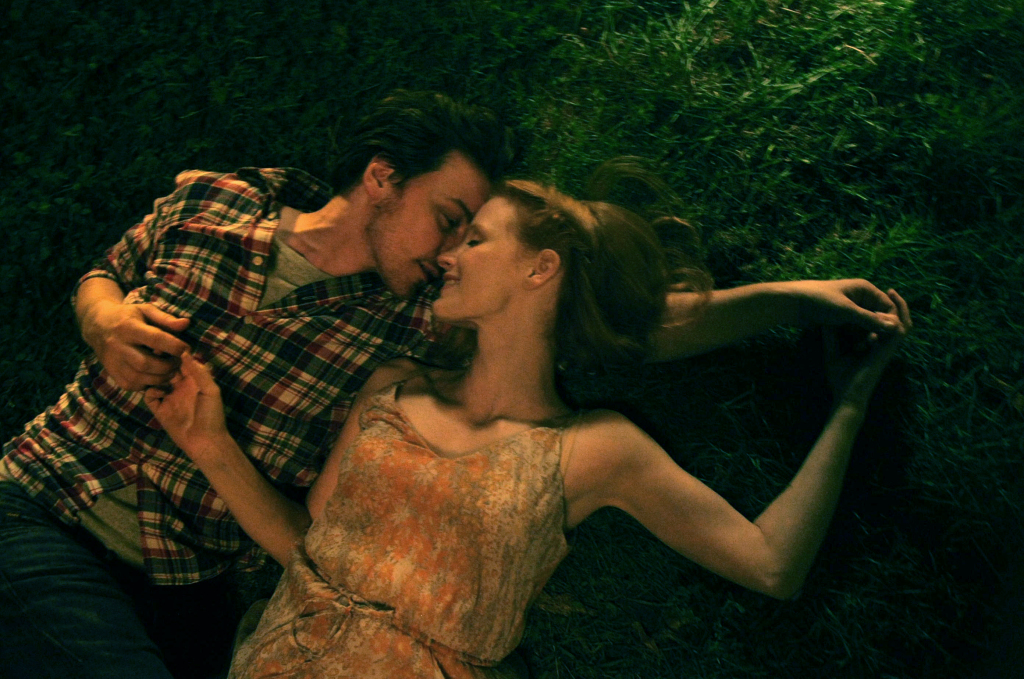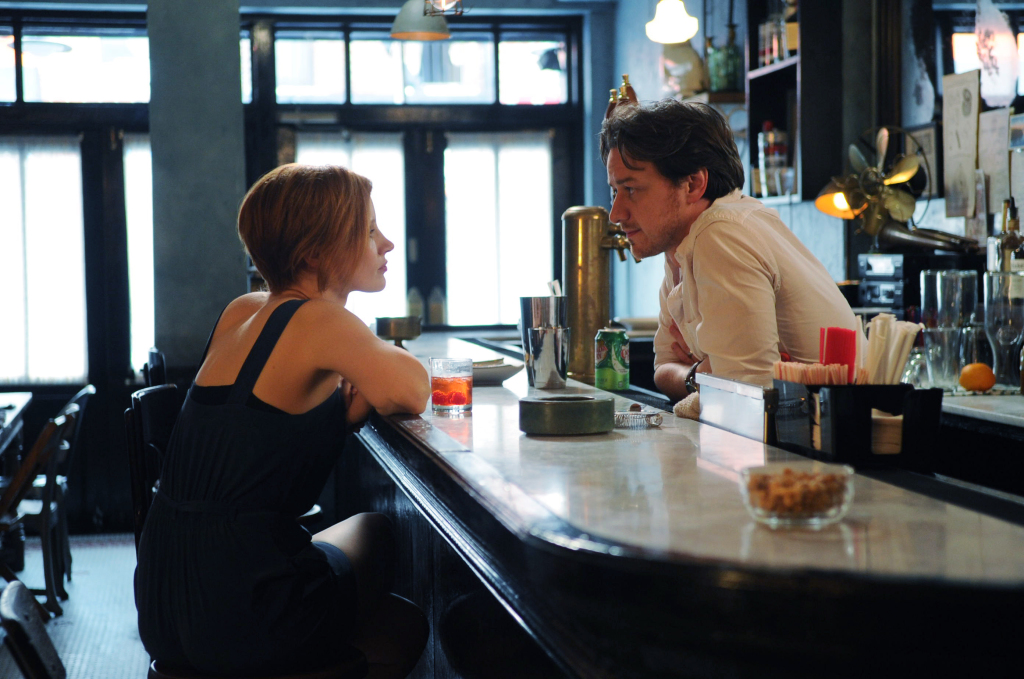 To quote one of the oldest (and most true) cliches in the book, there are two sides to every story. Especially if you’re dealing with a relationship.
To quote one of the oldest (and most true) cliches in the book, there are two sides to every story. Especially if you’re dealing with a relationship.
Director and writer Ned Benson’s The Disappearance of Eleanor Rigby takes that adage literally and delivers on it. To tell it short and spoiler-free, the plot centers around a NYC couple, who, after a phenomenal withholding of exposition, are revealed to be married and coping with a trauma that has caused their relationship to disintegrate. What makes this film truly unique, however, is that it was screened at the Toronto Film Festival in 2013 as two separate films back to back, Her and Him, without an intermission (totaling just over three hours long). Each film focuses solely on the story and perspective of one half of the couple. Her follows Eleanor Rigby (portrayed by a radiant, ever heart-wrenching Jessica Chastain), a woman who seeks to cope by reinventing herself in the wake of tragedy, while Him explores Conor Ludlow’s (James McAvoy; that man gives everything to any scene he’s in) driving need to keep his relationship intact, even though his wife has practically vanished from his life. There is an incredible supporting cast–Ciarán Hinds as Conor’s father, William Hurt and Isabelle Huppert as Eleanor’s parents, Viola Davis as Eleanor’s professor-turned-friend, and Bill Hader (side note: big fan of his transition into serious acting) as Conor’s best friend–but it is the unique and segmented perspectives of Conor and Eleanor, telling two entirely different stories, at the story’s core.
Yet while the two films are structurally and narratively disparate, Her and Him were edited together into one two-hour long piece, Them, for more convenient and widespread 2014 distribution before the release of Her/Him into smaller art house theatres a few weeks later (insert lamentation here about how art in Hollywood is dying by the grubby hands of business).
I saw Them first, and looking back on it after seeing Her/Him, Them’s biggest flaw is that it tries to squeeze two extremely different stories into one concise, tidy film—an idea that seems to transgress against the original premise that heavily revolves around the fact that not all stories are that simple. Them relies on the fact that Eleanor’s version of the story essentially is the plot–it’s most of Her peppered with a few scenes from Him. It makes sense that it does, seeing as Her follows a more obvious, three-act, hero’s journey convention: Eleanor, knocked down by grief, seeks to grow past her struggles and emerge better. While segments from Him begin and end the movie, in Them we get little idea as to who Conor actually is (a concept beautifully explored through scenes with his father in Him) and how he feels about Eleanor’s disappearance in order to fix herself, besides that he feels “sad.”
Additionally, the smooth narrative of Her and Him became disjointed when chopped up and edited into Them. The justified motivations of Conor and Eleanor in their respective movies become erratic in Them, as we experience abrupt shifts in emotion between cuts, making them seem deliberate and ungrounded. Because of this abruptness, I wanted more. Luckily, there was more out there. I could speculate on the little details to fill in these drastic shifts in emotion, but I had a feeling that Ned Benson would give them to me when I saw the entire three hours of Her/Him three weeks later. I knew it had to matter that there were two sides to the story.

And then I saw Her/Him and it all made sense. Well, it didn’t all make sense, but it certainly satiated my need for “more” after I saw Them. Yes, we got more plot and better understood the motivations of Eleanor and Conor, now that they each have their own movie. But, in seeing scenes shared between the movies, scenes that I thought could and would be repeated verbatim, perspective became more than just the story being told—it was how we were told it.
Her and Him rely on a strong sense of visual storytelling to explore the two divergent viewpoints. If you’re into colors and symbolism, watch these films. To differentiate between perspectives, cinematographer Chris Blauvelt used a different hue for each: Conor’s highlighted a cool color palette, while Eleanor’s imbued with warm tones. You can break out your color theory and speculate on these choices if you want to, but the visually stunning moments of the film emerged when these two colors interacted together. In one scene, out of focus, blue neon from the New York streets mesh with yellow fireflies floating in the park, as if to remind us, “hey, while one character may have disappeared, they will always be present.” In the split narrative, colors symbolize the lingering presence of another’s perspective.
Which is important, because on Benson’s end, Her/Him’s visual craft highlights the subjectivity of perspective. There were times when I thought I could get away with not fully paying attention to the handful of scenes from the first film revisited in the second film, but instead found myself captivated trying to remember if the scene was the same as before, digging up the minutia in my memory of each camera angle, line of dialogue, choice in blocking. Spoiler alert: almost every time, it wasn’t the same scene. The changes started real subtle but eventually progressed to show obvious differences in writing and mood. In one instance of subtle change, take a scene in which Conor and Eleanor share a strained conversation sitting on a curb. In Her, I recalled a large distance between the two, using a wide camera angle to barely fit the two in one shot, an air of uncomfortable emotional and physical distance between them. But in Him, it was a medium shot, and they were practically touching. Yes, you could say that the differences in composition between the two visually echoes the differences in emotion—Conor’s unwillingness to let go of Eleanor, Eleanor’s need to seek a refuge away from her past.
But what blew me away with those minute differences is how much I realized I accept the medium of film to be a singular truth. We are immersed in a dark theatre for a couple of hours in a world so meticulously crafted by writers and cinematographers and directors and editors that we acknowledge their world as the only viable one. Seeing how small changes can alter what a scene means shows how unstable truth in film is. We accept film as a reproduction of reality, but we never realize how constructed that reality is–how intentional the camera angles are, how deliberate the panning is. There may be two sides to every story, but there are also infinitesimal truths in every story, and it is up to the storyteller to decide what realities they want to unearth and what they want to leave behind. We aren’t getting an objective truth, persay, but a storyteller’s construction of it, what they want the truth to be. And in life, isn’t our creating a personal perspective just this same selective piecing together of moments?
In The Disappearance of Eleanor Rigby: Her/Him, Benson gets this and is exploiting it for all it’s worth, even if it doesn’t seem that way in Them. With Conor and Eleanor’s relationship, I don’t know which reality I accept as “real,” or if there even is a reality at all. And the point is we aren’t going to get one, because right and wrong are not simple and together and apart are complicated and coping and getting better mean different things to different people.
I’ll take two realities. It’s the closest thing to the truth I’m going to get.
